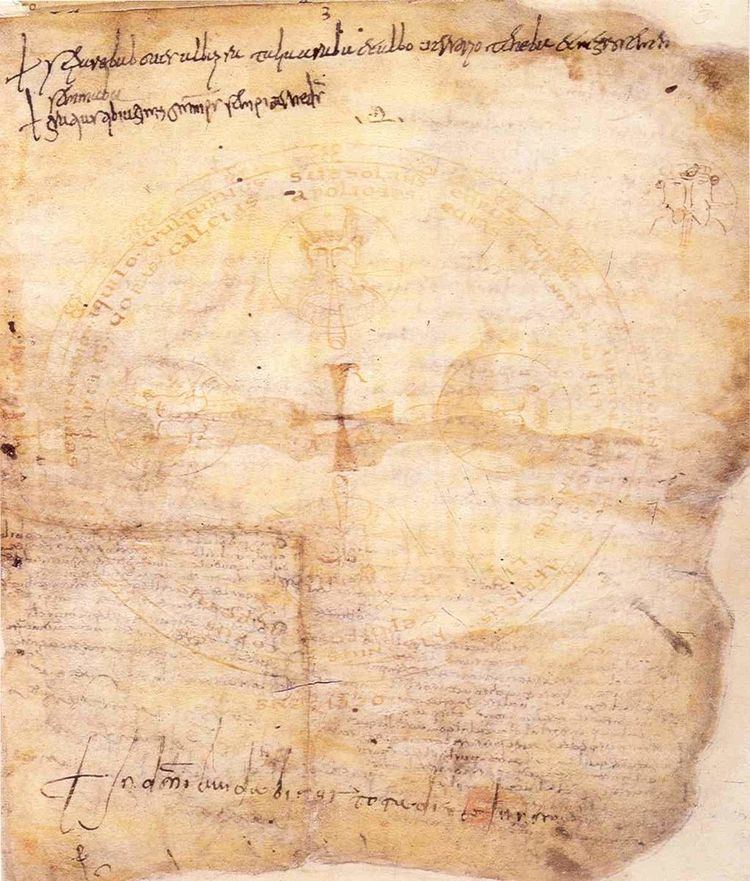 | ||
Date 8th or early 9th century | ||
The Veronese Riddle is a riddle written in late Vulgar Latin on the margin of a parchment, on the Verona Orational, probably in the 8th or early 9th century, by a Christian monk from Verona, in northern Italy. It was a very popular riddle in the Middle Ages and has survived into dialects to date. Discovered by Luigi Schiaparelli in 1924, it is considered the first document ever written in the Italian language along with the Placiti Cassinesi.
Contents
Text
Original Text:
Se pareba bovesalba pratalia arabaalbo versorio tenebanegro semen seminabaRough Translation:
In front of him (he) led oxenWhite fields (he) plowedA white plow (he) heldA black seed (he) sowedExplanation
The lines of this riddle tell us of a somebody with a "pair of oxen" (boves) who used to plow "white fields" (alba pratalia) with a "white plow" (albo versorio), sowing a "black seed" (negro semen). This person is the writer himself, the monk whose business is to copy old manuscripts. The two oxen are his fingers which draw a white feather (the white plow) across the page (the white fields), leaving black ink marks (black seed).
Origins of the "Indovinello"
This document dates to the late 10th-early 11th century and was followed by a small thanksgiving prayer in Latin: gratias tibi agimus omnip(oten)s sempiterne d(eu)s. These lines were written on codex LXXXIX (89) of the Biblioteca Capitolare di Verona. The parchment, discovered by Schiapparelli in 1924 is a Mozarabic oration by the Spanish Christian Church, i.e. a document in a Romance language first written in Spain in an area influenced by the Moorish culture, probably around Toledo. It was then brought to Cagliari and then Pisa before reaching the Chapter of Verona.
Text analysis and comments
Many more European documents seem to confirm that the distinctive traits of Romance languages occurred all around the same time (e.g. France's Serments de Strasburg). Though initially hailed as the earliest document in Italian in the first years following Schiapparelli's discovery, today the record has been disputed by many scholars from Bruno Migliorini to Cesare Segre and Francesco Bruni, who have placed it at the latest stage of Vulgar Latin, though this very term is far from being clear-cut and Migliorini himself considers it dilapidated. At present, however, the Placito Capuano (960 A.D.) (the first in a series of four documents dating 960-963 A.D. issued by a Capuan court) is considered to be the first document ever written in Italian, although Migliorini concedes that since the Placito was put on record as an official court proceeding (and signed by a notary), Italian must have been widely spoken for at least one century.
Some words stick indeed to the rules of Latin grammar (boves with -es for the accusative plural masculine, alba with -a suffix for the plural neuter). Yet more are distinctly Italian, with no cases and producing the typical ending of Italian verbs: pareba (It. pareva), araba (It. arava), teneba (It. teneva), seminaba (It. seminava) instead of Latin parebat, arabat, tenebat, seminabat. Albo versorio and negro semen have replaced Latin album versorium and nigrum semen. Versorio is still the word for "plow" in today's Veronese dialect (and the other varieties of Venetian language) as the verb parar is still the word for 'push on', 'drive', 'lead' (in Italian spingere, guidare). Michele A. Cortelazzo and Ivano Paccagnella say that the plural -es of boves may well be considered Ladin (a Romance language spoken in parts of Veneto, Trentino and South Tyrol) and therefore not Latin, but Romance. Albo is early Italian, especially since German blank entered Italian usage later, leading to current Italian bianco (white).
